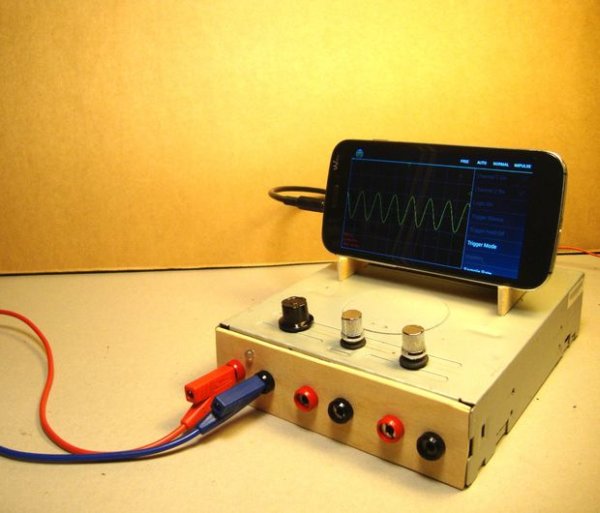Summary of OscilloPhone: Use your Smartphone as an Oscilloscope / Signal Generator
The OscilloPhone project transforms a smartphone into a portable oscilloscope and signal generator for electronics enthusiasts. It features an oscilloscope input for signals between 150 Hz and 15 kHz, supporting inputs up to ±50V with safety alerts. The signal generator can output sinusoidal, square, and triangular waveforms up to 15 kHz, with adjustable amplitude via a potentiometer. Additionally, it includes a power output capable of delivering up to 2A. The project builds upon and improves a circuit originally created by chipstein, making these essential tools more accessible and affordable for students and makers.
Parts used in the OscilloPhone project:
- Smartphone (as the main platform)
- Oscilloscope input circuit (based on chipstein's design)
- Signal generator output circuit
- Signal generator power output circuit
- Potentiometers (for signal amplitude adjustment)
- Warning LED (for high signal alert)
Oscilloscopes and Signal Generators are two essential electronics devices to create and test electronic circuits. Unfortunately, these devices are very expensives for students starting electronics, or makers who want use electronic circuits in their creations just once…
The idea of my project is to rethink your smartphone as a portable, powerful and secured platform, able to simulate an oscilloscope and a signal generator for your electronic circuits. Here, your phone isn’t just an accessorize or an ordinairy remote control : it becomes the center of the project, and a tool to help you create better things in the future.
The OscilloPhone project includes:
- an oscilloscope input for visualize electronic signals ranging from 150 Hz to 15kHz. Beyond this bandwidth, the displayed signals have a lower quality. Signals up to ±50V up can be injected on the input of the circuit. A warning LED alerts the user when a too high signal is measured.
- a signal generator output, able to generate sinusoidal, square and triangular signals up to 15kHz. A potentiometer is used to adjust the signal amplitude.
- a signal generator power output, able to generate sinusoidal, square and triangular signals up to 15kHz and 2A. A potentiometer is used to adjust the signal amplitude.
A part of this project is based on an electronic circuit invented by chipstein. I reused and improved his circuit to include it in my project.
When writing this tutorial, I wanted to provide excellent quality pictures to facilitate the making of my project. I retouched some photos to get a pure white background (see step 2) using the recent Antzy Carmasaic‘s Instructable: “Pure White Background Photography Using Smartphone”
Those devices are very important for an engineer on the go or any maker who wants to build electronic circuits. They are the only way to test that your electronic circuit operates as well as you want with electronic signals.
The Signal Generator :
“Signal generators, also known variously as function generators or waveform generators, are electronic devices that generate repeating or non-repeating electronic signals. They are generally used in designing, testing, troubleshooting and repairing electronic or electroacoustic devices.” – definition of signal generator by Wikipedia
For more detail: OscilloPhone: Use your Smartphone as an Oscilloscope / Signal Generator

